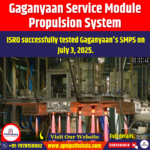| GS Paper III: Achievements of Indians in Science and Technology, Indigenization of technology and developing new technology |
Aditya L1 is India’s first solar mission conducted from space, aimed at studying the Sun.
It was launched by the Indian Space Research Organisation (ISRO) on September 2, 2023, and placed into a halo orbit around the Sun-Earth Lagrange point 1 (L1).
The Aditya-L1 mission enables a sustained observation of the Sun without interruptions, overcoming the frequent obstructions caused by the Earth in Low Earth Orbits.
The Aditya-L1 mission will help India create its space-based solar observatory, offering various benefits for everyday use. Moreover, the mission’s success would position ISRO among the prestigious ranks of NASA and ESA.
Why is there a Need for Solar Mission?
The Sun is the nearest star to Earth, about 150 million kilometres away, and the largest object that serves as the energy source for our solar system.
- It is a hot, luminous ball made up of hydrogen and helium gases.
- At its core, the Sun reaches temperatures as high as 15 million degrees Celsius, where nuclear fusion takes place, fueling the Sun’s energy.
- The photosphere, or the Sun’s visible surface, is relatively cooler, with a temperature of approximately 5,500°C.
- The Sun powers Earth’s systems but also poses risks; solar storms can affect infrastructure, and mysteries like the intense heat of the corona, the drivers of the solar cycle, and the sources of solar wind, flares, and Coronal Mass Ejections (CMEs) are still not fully understood.
- Unraveling the Sun’s complex magnetic behaviour is crucial for advancing space weather forecasting, safeguarding technological assets, and deepening our understanding of stellar evolution. The Aditya-L1 mission highlights India’s pursuit to uncover these solar mysteries.
Aditya-L1 Mission: Capabilities and Goals
Aditya-L1 was launched from the Satish Dhawan Space Centre in Sriharikota using a PSLV XL launch vehicle, aiming to set up a solar observatory in a halo orbit around the Sun-Earth L1 Lagrange point.
The mission includes seven payloads designed to study the Sun’s characteristics through visible and X-ray spectrometers, a coronagraph, solar wind and energetic particle analyzers, and magnetometers.
This wide range of observational tools will investigate various layers of the Sun, including the corona, chromosphere, and photosphere, as well as flares and coronal mass ejections.
Primary Scientific Goals of the Aditya L1 Mission:
- To understand the processes responsible for heating the solar corona and accelerating the solar wind.
- To examine how Coronal Mass Ejections (CMEs), solar flares, and space weather near Earth are initiated.
- To explore the connection and behavior of different layers within the solar atmosphere.
- To study the distribution of solar wind and the differences in temperature along various directions (temperature anisotropy).
Payloads and its Objectives
Payload | Objectives |
Remote Sensing Payload | |
Visible Emission Line Coronagraphic (VELC) | Examines the solar corona and tracks the behaviour of Coronal Mass Ejections. |
Solar Ultra-violet Imaging Telescope (SUIT)
|
|
Solar Low Energy X-ray Spectrometer (SoLEXS) |
|
High Energy L1 Orbiting X-ray Spectrometer (HEL1OS)
|
|
In-situ Payloads | |
Aditya Solar Wind Particle Experiment (ASPEX) | Investigates solar wind and energetic ions. Examines their energy distribution |
Plasma Analyser Package for Aditya (PAPA) | Gathers information on plasma properties and composition in interplanetary space, and provides understanding of how solar wind interacts with its environment. |
Advanced Tri-axial High-Resolution Digital Magnetometers (MAG) | To detect the low-intensity magnetic field present in interplanetary space. One is situated at the tip of a 6-meter retractable boom and the other placed 3 meters from the spacecraft along the boom. |
Lagrange Point L1 :
L1 is a point in space where the gravitational forces of two large bodies, such as the Sun and Earth, are in equilibrium, creating a stable location. Positioned approximately 1.5 million kilometres from Earth towards the Sun, L1 offers a continuous, unobstructed view of the Sun, without interruptions from eclipses or occultations. Placing a solar observatory at L1 has several key advantages:
- It allows for constant surveillance of the Sun without any view being blocked, facilitating the observation of solar storms as they develop and travel towards Earth.
- Satellites at L1 can maintain a fixed orientation towards the Sun, unlike those in elliptical heliocentric orbits, such as the Parker Solar Probe.
- Due to the gravitational balance at L1, satellites require very little fuel to stay in position.
- L1 provides a strategic early viewpoint to detect coronal mass ejections and solar flares before they impact Earth, enhancing lead time for space weather forecasting.
- The success of the Solar and Heliospheric Observatory (SOHO) already located at L1 underlines the point’s utility for solar observation.
Significance of Aditya-L1 mission
The Aditya-L1 mission is a pivotal development in space science and technology for multiple reasons:
- India’s Own Solar Observatory in Space: Aditya-L1 establishes India’s first dedicated solar observatory in space, marking a new frontier.
- Building on ISRO’s Legacy: The mission draws on ISRO’s extensive experience from past missions like Chandrayaan-1, Astrosat, and UVIT, expanding its scientific endeavors beyond Earth’s orbit.
- Advancing Space Capabilities: It showcases India’s growing prowess in advanced space technology, elevating ISRO’s status among the world’s leading space agencies, including NASA, ESA, and CNSA.
- Entering Solar Physics: Aditya-L1 marks India’s debut mission focused on solar studies, similar to NASA’s Parker Solar Probe, bringing India into the field of solar physics.
Broadening India’s Space Technology Capabilities:
- Continuous monitoring of the Sun, particularly the corona and solar storms, will enhance India’s space weather forecasting abilities, with critical applications in safeguarding Earth’s satellite systems and power infrastructure.
- The mission validates India’s skills in executing challenging deep space missions and in crafting specialized spacecraft and instruments for advanced scientific exploration.
- It diversifies ISRO’s technological portfolio, moving beyond its traditional strengths in remote sensing and communication to embrace more advanced space science endeavors.
Future Solar Exploration:
- Aditya-L1 solidifies India’s status as a prominent space-faring nation with advanced expertise in both satellite technology and interplanetary science missions.
- By establishing India as a leader in space exploration, proficient in satellite operations and interplanetary missions, Aditya-L1 sets the stage for the country to emerge as a global center for solar system research.
- The mission also paves the way for studying the fascinating solar poles, solving the mysteries of our nearest star, and deepening our understanding of the universe.
- ISRO plans to advance its solar studies with future missions like Aditya-L2 and Aditya-L3, which will be placed in highly elliptical orbits. The Aditya-L2 satellite, positioned at the L2 point, is set to capture the first direct images of the far side of the Sun.
Way Forward
Advancements and Challenges of Aditya-L1:
- Aditya-L1 marks a pioneering step for India in the field of solar studies and space-based astronomy, initiating a long-term quest for uncovering the mysteries of our life-sustaining star.
- Although groundbreaking, Aditya-L1 faces limitations, such as resource constraints and the inherent challenges of operating from the L1 point. To investigate the multi-directional nature of solar energy eruptions, extending observations beyond the L1 point will be crucial.
- Future missions should be aimed at the L5 point to enhance the study of Earth-directed CME events and provide more precise space weather predictions.
- Exploring the Sun’s magnetic fields and polar regions is vital for a comprehensive understanding of solar processes, necessitating missions to the Sun’s poles despite technological hurdles.
- Missions that focus on the polarization of solar radiation across different wavelengths would significantly contribute to our understanding of various solar phenomena.
Explore our courses: https://apnipathshala.com/courses/
Explore Our test Series: https://tests.apnipathshala.com/









